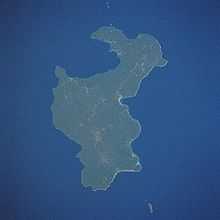Lifou
| Lifou | |
|---|---|
 | |
 | |
| Coordinates: 20°58′00″S 167°14′00″E / 20.9667°S 167.2333°ECoordinates: 20°58′00″S 167°14′00″E / 20.9667°S 167.2333°E | |
| Country | France |
| Sui generis collectivity | New Caledonia |
| Province |
Loyalty Islands (provincial seat) |
| Government | |
| • Mayor | Néko Hnepeune |
| Area | |
| • Land1 | 1,207.1 km2 (466.1 sq mi) |
| Population (2004 census) | |
| • Population2 | 10,320 |
| • Population2 Density | 8.5/km2 (22/sq mi) |
| Ethnic distribution | |
| • 1996 census |
Kanaks 96.9% Europeans 2.6% Polynesians 0.1% Other 0.4% |
| INSEE/Postal code | 98814 / 98820 |
| Elevation |
0–104 m (0–341 ft) (avg. 30 m or 98 ft) |
|
1 New Caledonia Land Register (DITTT) data, which exclude lakes and ponds larger than 1 km² (0.386 sq mi or 247 acres) as well as the estuaries of rivers. 2 Population without double counting: residents of multiple communes (e.g., students and military personnel) only counted once. | |
Lifou [lifu] is a commune of France in the Loyalty Islands Province of New Caledonia in the Pacific Ocean.
Geography
Lifou is made up of Lifou Island, the largest and most heavily populated of the Loyalty Islands,[1] its smaller neighbour Tiga Island, and several uninhabited islets in between these two. All these islands lie among the Loyalty Islands, 190 km (120 mi) to the northeast of New Caledonia's mainland. At 1,146 km2 (442 sq mi), Lifou Island is the largest atoll in the world.[2]
The town of Wé, on Lifou Island, is the administrative centre of the commune of Lifou as well as the provincial seat of the Islands Province.[1]
Geology
Like Maré and Ouvéa, the other Loyalty islands, Lifou is made of fossil coral.[3] Lifou is a makatea (raised coral atoll), an ancient lagoon slowly raised by geological processes.[4] Due to the uplift, Lifou consists of a wide, flat center surrounded by cliffs which correspond to the ancient reefal cliffs.[5] The coral rock exhibits high porosity and hence, neither Lifou nor any of the other Loyalty Islands have surface water.[6] It does, however, have a large freshwater reservoir which can be accessed through caves. These caves were used in the past when searching for fresh water, and are very important to the island's mythology.
History
Economic
The first Europeans to have contact with Lifouans were whalers, who had very limited, and certainly not friendly, communications with them.[7] Sandalwood traders also came to New Caledonia around 1841.[8]
Religious
By the mid-19th century, there were Anglican missionaries at work on Lifou, although there had been natives and Polynesian immigrants doing religious work before then.[9] In 1843, French Catholic missionaries arrived on Lifou;[9] shortly afterward, the Anglicans and Catholics became involved in a religious war that lasted until the French takeover of Lifou in 1864.[10] The missionaries even established a school on Lifou Island,[9] and from 1840 to the early 20th century taught most of the population to read.[4] They did enough religious work that in 1998 the Lifouans were referred to as "devout Christians."[11]
Economy
Tourism
Lifou is a popular cruise port,[12] with many cruises coming from Australia.[13] The most common port-of-call is Easo; the ships anchor just off the island and tender passengers ashore, being too large for the wharf there. Lifou is known for its snorkeling.[14]
Farming
The Lifouans grow several crops, including yams, taro, and bananas; they also produce copra.[1]
Famous residents
Christian Karembeu, a French footballer who won the 1998 FIFA World Cup with the French National side, is from Lifou.[15]
Images of Lifou
-

Map of Lifou island -
Coral reef off Lifou Island
References
- ↑ 1.0 1.1 1.2 Murray, Lorraine (2009), "Lifou Island", Encyclopædia Britannica Online (Encyclopædia Britannica), retrieved 2009-07-16
- ↑ Calder, Joshua (2003-12-14), Island Misinformation, retrieved 2009-07-18
- ↑ Wallace, Alfred Russel; Keane, Augustus Henry (1888), Augustus Henry Keane, ed., Australasia (5th ed.), E. Stanford
- ↑ 4.0 4.1 Lenwood, Frank (1917), Pastels from the Pacific, Oxford University Press
- ↑ Woodward, Henry (1899), Geological Magazine, Cambridge University Press
- ↑ Parrott-Sheffer, Chelsey (2009), "New Caledonia: French Overseas Country, Pacific Ocean", Encyclopædia Britannica Online (Encyclopædia Britannica), retrieved 2009-08-13
- ↑ McFarlane, Samuel (1873), The Story of the Lifu Mission, London: James Nisbet & Co.
- ↑ Keesing, Roger (1988), Melanesian Pidgin and the Oceanic Substrate, Stanford University Press, ISBN 0-8047-1450-9
- ↑ 9.0 9.1 9.2 Garrett, John (1982), To live among the stars: Christian origins in Oceania (2nd ed.), University of the South Pacific, ISBN 2-8254-0692-9
- ↑ Stanley, David (2004), South Pacific (8th ed.), Moon Handbooks, p. 1136, ISBN 1-56691-411-6
- ↑ Douglas, Bronwen (1998), Across the Great Divide: Journeys in History and Anthropology, Taylor & Francis, ISBN 90-5702-306-7
- ↑ Fleming, Donna (2008-09-10), Lifou: Dropping in on paradise, The New Zealand Herald, retrieved 2009-07-17
- ↑ McKinnon, Ian (2008-10-01), Lifou - a little island treasure, The Sydney Morning Herald, retrieved 2009-07-24
- ↑ Maley, Jacqueline (2008-10-01), Sail Away, Sail Away, The Sydney Morning Herald, retrieved 2009-08-07
- ↑ Maddaford, Terry (2008-12-04), Passion burns deeply for French star, The New Zealand Herald, retrieved 2009-07-24
External links
| Wikimedia Commons has media related to Lifou. |
| ||||||||

